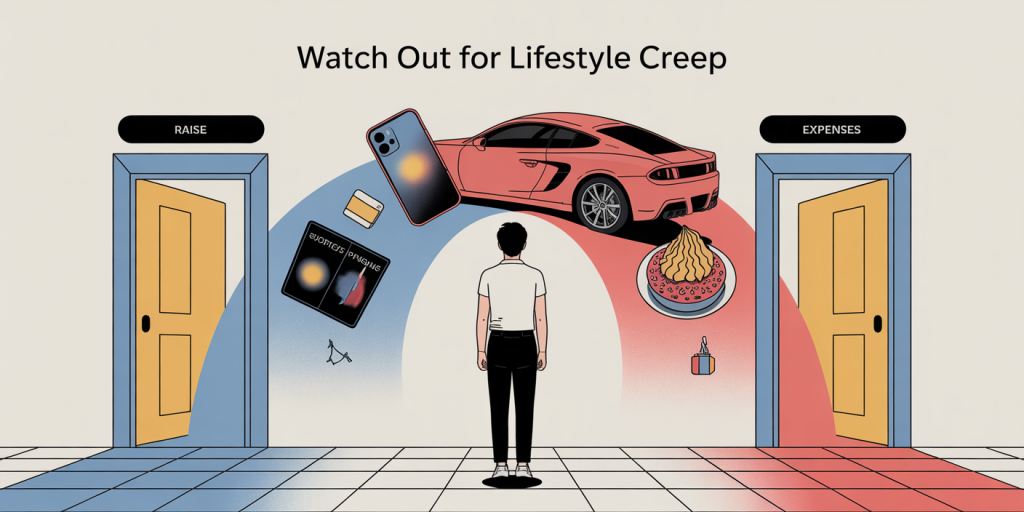Lifestyle Creep: What It Is and How to Stop It From Stealing Your Wealth
As income increases, so does the temptation to spend more. What starts as a modest raise quickly leads to upgrading gadgets, dining out frequently, or moving to a pricier neighborhood. This phenomenon, known as lifestyle creep or lifestyle inflation, quietly drains your financial resources and undermines your long-term wealth accumulation plans. Understanding lifestyle creep is crucial for maintaining financial health and achieving meaningful wealth growth.
Lifestyle creep is the gradual increase in spending when one’s income rises, making it difficult to save or invest more despite a higher paycheck. This article explores what lifestyle creep is, the psychology behind it, practical examples, how to identify it, and actionable steps to prevent it from derailing your wealth-building goals.
Understanding Lifestyle Creep: The Silent Wealth Killer
Lifestyle creep occurs when discretionary spending grows proportionally with income, often without conscious awareness. For example, a worker who gets a 10% raise might start dining at expensive restaurants more often, buy a luxury car, or subscribe to premium services, resulting in expenses that nearly offset the income increase. The key problem is that while income rises, savings and investments do not grow accordingly.
Research by The American Institute of CPAs (AICPA) reveals that nearly 70% of Americans increase discretionary spending when their income rises, but only 35% increase their savings rate. This shows how prevalent lifestyle creep is and how it impacts financial security.
A real-life case involved a tech professional in Silicon Valley who earned $150,000 a year and consistently upgraded their living standards each time they received a raise. Despite increasing salary, they found themselves paycheck to paycheck and unable to save for retirement after five years. This example illustrates how lifestyle inflation can trap individuals in a cycle of spending without wealth accumulation.
—
Psychological Drivers Behind Lifestyle Creep
Lifestyle creep isn’t merely about money—it’s driven by psychological and social factors. The desire to keep up with peers or societal norms creates pressure to upgrade lifestyles. Behavioral economics identifies the “hedonic treadmill,” where people quickly become accustomed to higher income and offset it with increased spending rather than enhanced well-being.

For example, a study published in the Journal of Consumer Research found that people spend more as their income grows because rising consumption maintains their sense of social status rather than increasing happiness. This contributes to a cycle where satisfaction temporarily spikes after a purchase but quickly returns to baseline, prompting further spending.
Social media exacerbates these pressures, making it easier to compare lifestyles and feel inadequate, prompting even more spending. This feeds into “keeping up with the Joneses,” a term describing how lifestyle inflation is often motivated by external validation.
Identifying Lifestyle Creep in Your Finances
Recognizing lifestyle creep early is key to controlling it. Start by tracking your expenses comprehensively over several months to compare spending patterns relative to income changes. Pay special attention to recurring discretionary expenses such as entertainment, dining, travel, and subscriptions.
Consider the following comparative table illustrating typical spending behaviors before and after an income increase:
| Category | Monthly Spending (Before 10% Raise) | Monthly Spending (After 10% Raise) | Change (%) |
|---|---|---|---|
| Dining Out | $200 | $350 | +75% |
| Entertainment | $150 | $250 | +66.7% |
| Clothing | $100 | $180 | +80% |
| Subscriptions | $50 | $90 | +80% |
| Savings | $500 | $550 | +10% |
This table reveals how non-essential expenditures rise disproportionately, while savings barely grow. Identifying such trends is the first step toward managing lifestyle creep effectively.
Another indicator is whether your savings rate stays constant or improves after a pay increase. The Financial Independence community suggests striving to raise your savings rate proportionally with income, e.g., if salary increases by 10%, savings should also increase by at least 10%.
Practical Strategies to Combat Lifestyle Inflation
Preventing lifestyle creep requires intentional financial discipline. The following strategies have proven highly effective:
1. Automate Savings and Investments
Automatically divert a set percentage of any income increase into savings or investment accounts. This “pay yourself first” method ensures extra income builds wealth rather than fuel lifestyle inflation.
For example, when switching jobs, some professionals commit to increasing their retirement contributions immediately with the raise. This guarantees long-term financial growth even as spending temptations arise.
2. Set Incremental Budget Limits
Create a budget with clearly defined limits for discretionary categories. Instead of inflating entertainment or dining budgets after a raise, keep spending steady and allocate more funds to wealth-building areas.
Consider budgeting software or apps like YNAB (You Need a Budget) or Mint, which help track and control spending dynamically.
3. Implement a Waiting Period for Big Purchases
Impose a 30-day waiting period before making large purchases that are lifestyle upgrades. This delay minimizes impulse decisions and aligns spending with genuine needs.
Real-Life Success: How Individuals Outsmart Lifestyle Creep
Several high-profile cases demonstrate disciplined financial management avoiding lifestyle creep. Warren Buffett, one of the world’s wealthiest individuals, famously lives modestly despite his immense wealth. He still resides in the house he bought in 1958 for $31,500 and avoids excessive consumption.

Similarly, many financial bloggers and early retirees emphasize “escaping the rat race” by resisting lifestyle inflation, saving aggressively, and focusing on financial independence. Jill and Josh from the blog “Our Next Life” showcased how living below their means and increasing savings percentage significantly accelerated their financial independence timeline despite rising incomes over their careers.
—
The Cost of Lifestyle Creep on Retirement Planning
Lifestyle creep can have disastrous consequences on retirement saving efforts. According to Fidelity’s data, the average American needs about $1.5 million in retirement savings to maintain a comfortable lifestyle. However, 58% of workers admit they increased spending as their salary increased, diminishing their ability to contribute adequately toward retirement funds.
To illustrate, consider this simplified comparison table estimating retirement savings after 20 years with and without lifestyle creep:
| Scenario | Annual Income Growth | Savings Rate | Retirement Savings After 20 Years |
|---|---|---|---|
| No Lifestyle Creep | 5% | 20% | $1,200,000 |
| With Lifestyle Creep | 5% | 10% | $600,000 |
This table starkly shows that failing to adjust spending habits can halve potential retirement savings, jeopardizing long-term financial security.
Future Perspectives: Tackling Lifestyle Creep in a Changing Economy
Looking ahead, tackling lifestyle creep will become increasingly important as wage growth occurs amid rising living costs due to inflation and economic fluctuations. The rapid advancement of technology and the gig economy offer new income streams, but also tempt new spending opportunities, increasing the risk of lifestyle inflation.
Financial advisors suggest boosting financial literacy and embracing minimalist or intentional living philosophies as powerful tools against lifestyle creep. Nationwide surveys indicate that millennials and Gen Z prioritize experiences over material goods, a trend that could mitigate excessive inflation in lifestyle if nurtured appropriately.
Moreover, digital banking platforms and AI-driven personal finance tools are poised to help consumers better monitor and limit lifestyle inflation through smart budgeting reminders and real-time expense tracking.
Ultimately, fostering a mindset focused on sustainable wealth rather than transient consumption is key. Encouraging young earners to understand the impact of lifestyle creep early can reshape generational wealth accumulation patterns, promoting financial independence and stability.
—
Lifestyle creep is a subtle yet significant threat to growing and preserving wealth. By understanding its psychological roots, identifying personal spending inflation, and adopting strategic controls, individuals can protect their financial futures. As economic conditions evolve, awareness and proactive financial management will remain essential in safeguarding your earnings from being silently eroded by lifestyle inflation.

